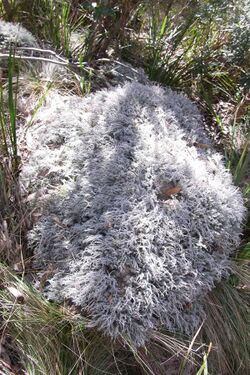Biology:Stereocaulon ramulosum
| Snow lichen | |
|---|---|

| |
| Barrington Tops National Park, Australia | |
| Scientific classification | |
| Domain: | Eukaryota |
| Kingdom: | Fungi |
| Division: | Ascomycota |
| Class: | Lecanoromycetes |
| Order: | Lecanorales |
| Family: | Stereocaulaceae |
| Genus: | Stereocaulon |
| Species: | S. ramulosum
|
| Binomial name | |
| Stereocaulon ramulosum Raeusch.
| |
| Synonyms | |
| |
Stereocaulon ramulosum, commonly known as snow lichen, is a terricolous fruticose lichen belonging to the family Stereocaulaceae.[1] It has cosmopolitan distribution. In the Australasian region, it is common in eastern Australia , New Zealand and has also been recorded at Lord Howe Island and Macquarie Island.[2]
Its habitat is often cooler, moist areas with a high level of cloud cover. It may be found on rocky ground or as an epiphyte on tree branches. Stereocaulon ramulosum was the first lichen known to contain an amylose polysaccharide.[3][4]
This species is unusual, as the fungal component is associated with two different chlorophyll forming species; usually there is only one. The more significant one is a green alga which gives the lichen its characteristic colour. The second is a cyanobacteria which is found in the cephalodia, a wart-like structure. Three different kingdoms are represented in this single life form; Fungi, Protista and Eubacteria.[5]
The generic name Stereocaulon is derived from ancient Greek stereós and Latin caulis, referring to the hard stem of the central part of the lichen.[6] The specific epithet ramulosum is derived from the Latin ramulose, and means "having many small branches".[7]
Phytochemistry
The characteristic secondary metabolite of S. ramulosum is atranorin, a depside. During the extraction phase, atranorin suffer an alcoholysis reaction, producing methyl/ethyl haemmatomate and methyl ß-orcinol carboxylate. Has been identified in New Zealand and in east central Africa, perlatolic acid, anziaic acid and methyl haemmatomate.[8] Methyl haemmatomate has in-vitro antifungical activity.[9] Huneck in Chiloe, Chile, identify atranorin, perlatolic acid and lobaric acid.[10] Also, in Pongo, Bolivia, Vila et al. aislate the polyol galactitol and 1,3,7-trimethylguanine, an unusual alkaloid.[11][clarification needed]
Carbohydrates have been found.[clarification needed]. A linear (1→3) linked ß-D-glucan,[3] and β-GalCer-lich, a new immune stimulant carbohydrate.[12]
References
- ↑ "Stereocaulon ramulosum" (in en). https://www.gbif.org/species/7247063.
- ↑ "Stereocaulon ramulosum". Atlas of Living Australia. https://biocache.ala.org.au/occurrences/search?q=lsid%3ANZOR-6-5277&qualityProfile=ALA#tab_mapView.
- ↑ 3.0 3.1 Madalena Baron, Philip A.J. Gorin, Marcello Iacomini (1988). "Isolation and identification of a linear (1→3)-linked β-d-glucan and other carbohydrate components of the lichen Stereocaulon ramulosum (SW.) Räusch". Carbohydrate Research (Elsevier) 177: 235–239. doi:10.1016/0008-6215(88)85057-2. https://www.sciencedirect.com/science/article/abs/pii/0008621588850572. Retrieved February 15, 2021.
- ↑ "Stereocaulon ramulosum". Australian Lichens. Australian National Herbarium. https://www.anbg.gov.au/lichen/photos-captions/stereocaulon-ramulosum-f-364.html.
- ↑ John Walter. "Living on the Edge". Wombat Forestcare Newsletter - September 2013. http://www.wombatforestcare.org.au/newsletters/WombatForestcareNewsletter25_Sept_13.pdf.
- ↑ "Stereocaulon alpinum". Association Française de Lichénologie - Les champignons lichénisés de France - AFL. Association Française de Lichénologie. https://www.afl-lichenologie.fr/Photos_AFL/Photos_AFL_S/Text_S/Stereocaulon_alpinum.htm.
- ↑ Michael L. Charters. "Calflora - Page R". Botanic Names. http://www.calflora.net/botanicalnames/pageR.html.
- ↑ Ramaut, J. L.; Serusiaux, E.; Brouers, M.; Corvisier, M. (1978). "Lichen Acids of the Stereocaulon ramulosum Group in Central East Africa". The Bryologist 81 (3): 415. doi:10.2307/3242244. ISSN 0007-2745. http://dx.doi.org/10.2307/3242244.
- ↑ Hickey, B.J.; Lumsden, A.J.; Cole, A.L.J.; Walker, J.R.L. (1990). "Antibiotic compounds from New Zealand plants: methyl haematommate, an anti-fungal agent from Stereocaulon ramulosum". New Zealand Natural Sci. 17: 49–53. https://ir.canterbury.ac.nz/server/api/core/bitstreams/b4f7db45-a814-4b92-aa69-ae41fe98c272/content.
- ↑ Huneck, Siegfried; Follmann, Gerhard (1967-04-01). "Notizen: Über die Inhaltsstoffe von Usnea pusilla (RAES.) RAES., Stereocaulon ramulosum (SWANS.) RAEUSCH. und Arthothelium pacificum FOLLM." (in de). Zeitschrift für Naturforschung B 22 (4): 461. doi:10.1515/znb-1967-0426. ISSN 1865-7117. https://www.degruyter.com/document/doi/10.1515/znb-1967-0426/html.
- ↑ Vila, Jose; Mollinedo, Patricia; Flores, Yonny; Sterner, Olov (December 2008). "1,3,7-TRIMETHYLGUANINE FROM THE LICHEN STEREOCAULON RAMULOSUM" (in en). Revista Boliviana de Química 25 (1): 1–3. ISSN 0250-5460. http://www.scielo.org.bo/scielo.php?script=sci_abstract&pid=S0250-54602008000100001&lng=es&nrm=iso&tlng=en.
- ↑ Baena, Andrés; Gomez-Giraldo, Lina; Gomez, Wilton A.; Pelaez, Carlos A. (2015-07-28). "Murine invariant natural killer T cells recognize glycolipids derived from extracts of the lichen Stereocaulon ramulosum". Revista Vitae 22 (1). doi:10.17533/udea.vitae.v22n1a02. https://revistas.udea.edu.co/index.php/vitae/article/view/21794.
Wikidata ☰ Q21321251 entry
 |

